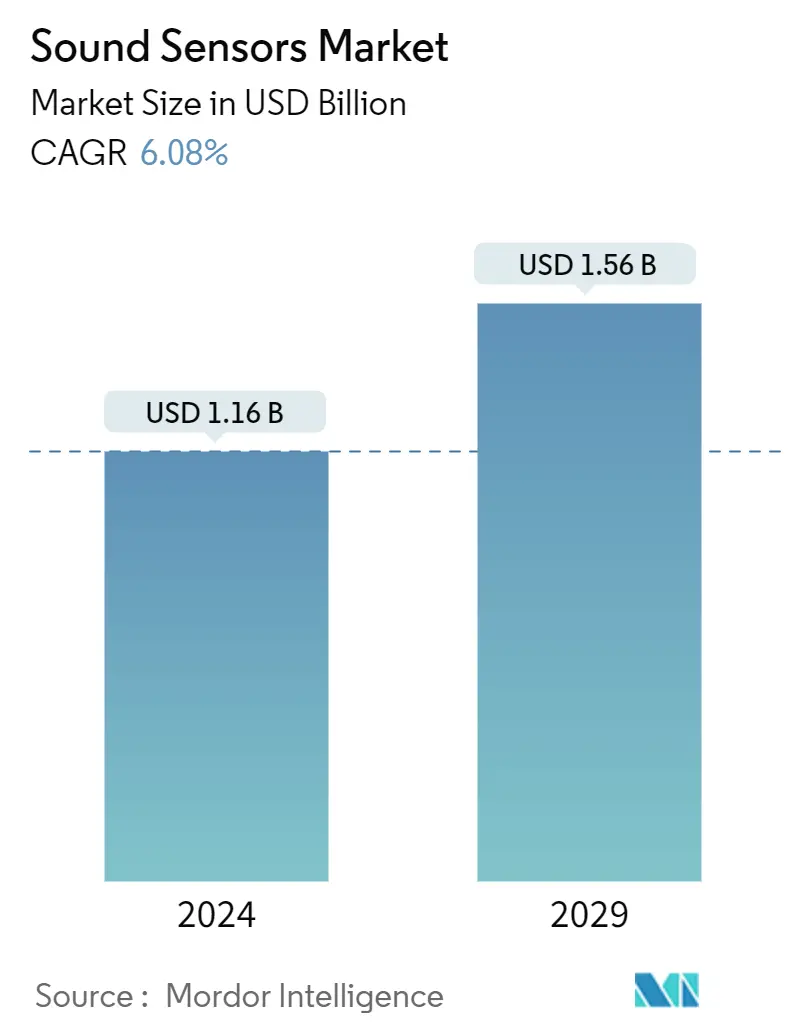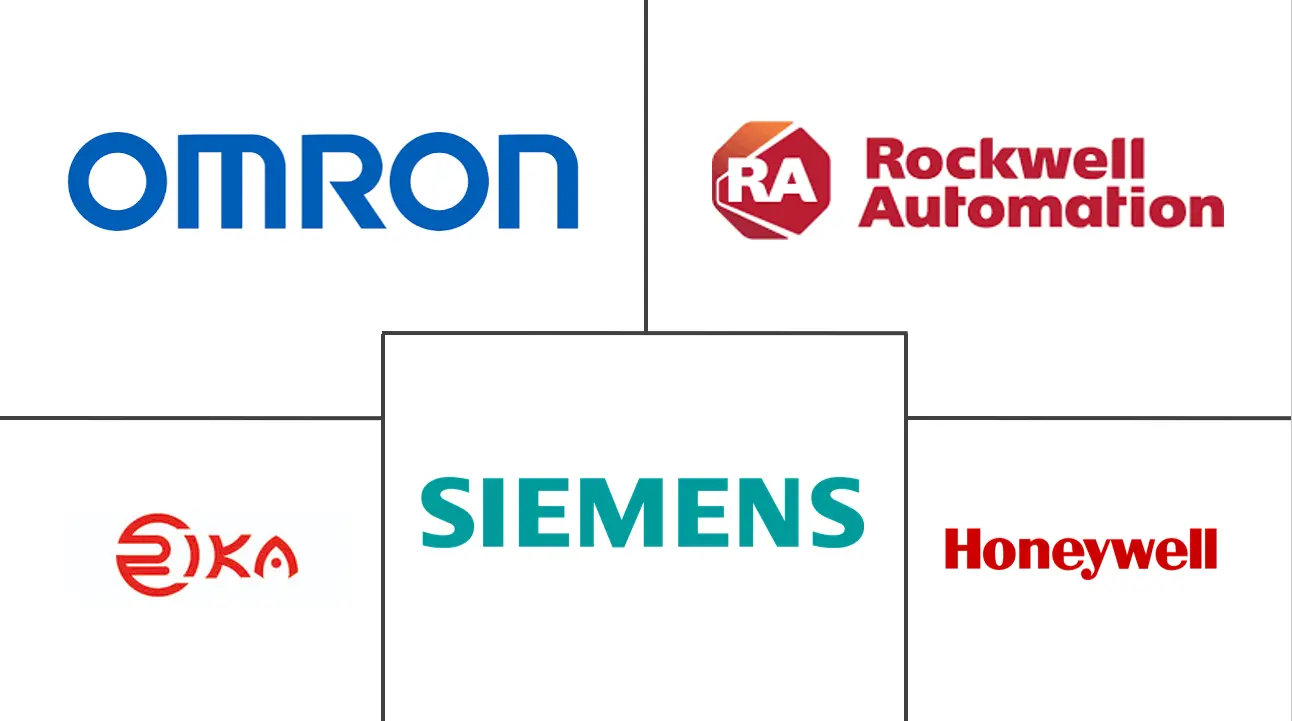Market Size of Sound Sensors Industry

| Study Period | 2019 - 2029 |
| Market Size (2024) | USD 1.16 Billion |
| Market Size (2029) | USD 1.56 Billion |
| CAGR (2024 - 2029) | 6.08 % |
| Fastest Growing Market | Europe |
| Largest Market | Asia Pacific |
Major Players
*Disclaimer: Major Players sorted in no particular order |
Sound Sensors Market Analysis
The Sound Sensors Market size is estimated at USD 1.16 billion in 2024, and is expected to reach USD 1.56 billion by 2029, growing at a CAGR of 6.08% during the forecast period (2024-2029).
- The rising demand for reliable and high-performance sensors is a primary driver responsible for the high growth rate of the sound sensors market. Several technology advancements in the market and decreasing manufacturing costs of sound sensors have also led to the increasing adoption of these sensors.
- For instance, digital signal processes play a crucial role in converting analog audio to digital format for use in a digital environment. They have undergone continual improvement, influencing the design, installation, and use of professionally installed sound systems.
- Sensor technology has enabled automated devices to interpret sounds and other data without extremely powerful intelligent processing. This has led to the development of compact, low-power systems that enable increased autonomy in machine-to-machine interactions and offer natural perceptual user interfaces for human-machine interactions.
- Advancements in sound sensor technology have led to improvements in sound quality and battery life for wireless earphones and headphones. These improvements are expected to lead to the market’s growth.
- However, the possibility of substituting sound sensors with other technologies (like microphones, ultrasonic sensors, etc.) is likely to restrain the growth of the market studied.
- In the post-COVID-19, there is an increased demand for transformation and creative solutions. In terms of newer technology, researchers are developing a new type of sensor that reacts to certain sound waves, causing it to vibrate. This Passive sound-sensitive sensors could be used to monitor buildings, earthquakes or certain medical devices and save millions of batteries. There is also interest by researchers in battery-free sensors for monitoring decommissioned oil wells. Gas can escape from leaks in boreholes, producing a characteristic hissing sound. Such a mechanical sensor could detect this hissing and trigger an alarm without constantly consuming electricity – making it far cheaper and requiring much less maintenance.
Sound Sensors Industry Segmentation
A sound sensor is a component/module that converts sound into a physical quantity to be measured into a signal that can be displayed, read, stored, or used to control some other amount. Sound sensors can be used to measure sound levels over a wide range of frequencies. They find applications in detecting weak signals, broadband signals, pipeline leaks, and tracking sound sources. Sound sensors also find underwater applications and can be used in the air to detect acoustic emissions and ultrasonic sounds.
The sound sensors market is segmented by end-user industry (consumer electronics, telecommunications, industrial, defense, healthcare, and other end-user industries) and geography (North America, Europe, Asia Pacific, and the Rest of the World). The market sizes and forecasts are in terms of value (USD) for all the above segments.
| By End-user Industry | |
| Consumer Electronics | |
| Telecommunications | |
| Industrial | |
| Defense | |
| Healthcare | |
| Other End-user Industries |
| By Geography*** | |
| North America | |
| Europe | |
| Asia | |
| Australia and New Zealand | |
| Latin America | |
| Middle East and Africa |
Sound Sensors Market Size Summary
The sound sensors market is poised for significant growth, driven by the increasing demand for high-performance and reliable sensors across various applications. Technological advancements and reduced manufacturing costs have facilitated the widespread adoption of sound sensors, which are integral in converting analog audio to digital formats and enhancing sound quality in devices like wireless earphones and headphones. The market is also witnessing innovations such as passive sound-sensitive sensors, which have potential applications in monitoring structures and detecting gas leaks without the need for constant power. However, the market's growth may be tempered by the potential substitution of sound sensors with alternative technologies like microphones and ultrasonic sensors. The rise of Industry 4.0 and the integration of robotics in manufacturing processes are expected to further propel the market, with countries like Germany and China leading initiatives to modernize their manufacturing sectors.
In the industrial sector, sound sensors play a crucial role in monitoring machinery and analyzing acoustic emissions, contributing to improved operational efficiency and safety. The market is supported by a robust ecosystem, with the adoption of IIoT and factory automation enhancing the utility of acoustic sensors. Government initiatives and funding, particularly in regions like the UK, are fostering the adoption of advanced technologies in manufacturing, creating new opportunities for market growth. The market is characterized by a fragmented landscape with key players such as Honeywell, Siemens, and Bosch, who are actively engaging in innovations and collaborations to meet evolving consumer needs. Recent developments, including Honeywell's DG Smart Sensor and Polysense's soundoise sensor clusters, highlight the ongoing advancements in sound sensor technology, catering to both industrial and smart city applications.
Sound Sensors Market Size - Table of Contents
-
1. MARKET INSIGHTS
-
1.1 Market Overview
-
1.2 Industry Attractiveness - Porter's Five Forces Analysis
-
1.2.1 Bargaining Power of Suppliers
-
1.2.2 Bargaining Power of Buyers
-
1.2.3 Threat of New Entrants
-
1.2.4 Threat of Substitute
-
1.2.5 Intensity of Competitive Rivalry
-
-
-
2. MARKET SEGMENTATION
-
2.1 By End-user Industry
-
2.1.1 Consumer Electronics
-
2.1.2 Telecommunications
-
2.1.3 Industrial
-
2.1.4 Defense
-
2.1.5 Healthcare
-
2.1.6 Other End-user Industries
-
-
2.2 By Geography***
-
2.2.1 North America
-
2.2.2 Europe
-
2.2.3 Asia
-
2.2.4 Australia and New Zealand
-
2.2.5 Latin America
-
2.2.6 Middle East and Africa
-
-
Sound Sensors Market Size FAQs
How big is the Sound Sensors Market?
The Sound Sensors Market size is expected to reach USD 1.16 billion in 2024 and grow at a CAGR of 6.08% to reach USD 1.56 billion by 2029.
What is the current Sound Sensors Market size?
In 2024, the Sound Sensors Market size is expected to reach USD 1.16 billion.

